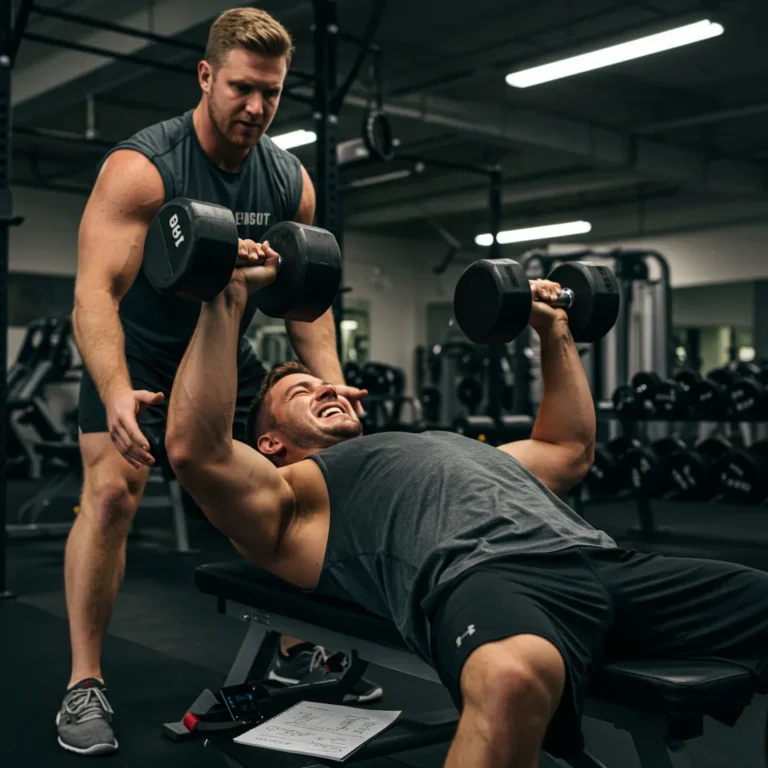
Here’s what blew my mind when I first discovered drop sets: recent research shows they can deliver the same muscle growth as traditional training but in 50-70% less time! I stumbled upon this game-changing technique during my own plateau-busting journey three years ago.
After months of stagnant muscle growth, implementing properly structured drop sets transformed my physique in ways I never expected. My arms grew an inch in six weeks, and my chest finally started filling out my shirts properly! The key was understanding that drop sets aren’t just about grinding out more reps – they’re a sophisticated method of maximizing muscle fiber recruitment and metabolic stress. This comprehensive guide reveals exactly how to use drop sets for hypertrophy, backed by both cutting-edge research and real-world application.
The Science of Drop Sets for Hypertrophy
Let me break down what’s actually happening inside your muscles during a proper drop set – it’s absolutely fascinating stuff.
When I first learned about the physiological mechanisms behind drop sets, everything clicked. I realized why my previous attempts at using them were so hit-or-miss.
The magic starts with muscle protein synthesis elevation. Research shows that drop sets can keep protein synthesis elevated for up to 48 hours post-workout, compared to 24-36 hours with straight sets. That’s nearly double the muscle-building window!
Here’s what’s happening at the cellular level: Drop sets create extreme metabolic stress through lactate accumulation and cellular swelling. This metabolic environment triggers powerful anabolic signaling pathways, particularly mTOR activation.
The motor unit recruitment pattern is where things get really interesting. Normally, your nervous system recruits muscle fibers in a predictable order – smallest to largest. Drop sets disrupt this pattern completely.
By reducing the weight after initial failure, you’re forcing recruitment of fresh motor units while the fatigued ones partially recover. It’s like having a relay race inside your muscle fibers.
Time under tension skyrockets with drop sets too. Instead of a typical 40-second set, you’re looking at 60-90 seconds of continuous muscle tension. This extended tension is crucial for hypertrophy because it maximizes the mechanical stimulus.
I’ve noticed that the muscle pump from drop sets is insane compared to regular sets. That’s not just for show – the cellular swelling contributes directly to muscle growth through stretch-mediated mechanisms.
Optimal Drop Set Structure for Muscle Growth
Getting the structure right is absolutely critical for hypertrophy. I wasted months doing drop sets wrong before I figured out the optimal approach.
The weight reduction percentage is where most people screw up royally. After extensive experimentation and research review, I’ve found that 20-25% weight drops are the sweet spot for muscle growth.
Here’s why: Drop too little (10-15%) and you can’t get enough additional reps to extend the growth stimulus. Drop too much (40-50%) and you’re training in the endurance zone rather than the hypertrophy zone.
Rest periods between drops are crucial too. Zero to ten seconds maximum – any longer and you lose the metabolic stress component that makes drop sets so effective for muscle growth.
I use a simple three-drop protocol: Starting weight to failure, drop 25%, continue to failure, drop another 25%, final push to failure. This gives you three distinct growth stimuli in one extended set.
Rep ranges should progress as you drop weight. I aim for 6-10 reps initially, 8-12 on the first drop, and 10-15 on the final drop. This keeps you in the hypertrophy sweet spot throughout.
The termination point is critical for growth. Stop when form breaks down significantly, not when you physically can’t move the weight. Quality reps build quality muscle.
Equipment matters hugely for optimal structure. Machines allow for faster weight changes and better form maintenance as fatigue sets in. Cable systems are particularly excellent for drop sets.
Best Exercises for Hypertrophy-Focused Drop Sets
Not all exercises are created equal for hypertrophy-focused drop sets. I’ve tested dozens of movements, and some clearly outperform others for muscle growth.
Isolation exercises reign supreme for drop set hypertrophy training. The single-joint focus allows you to maintain perfect form while maximizing metabolic stress on the target muscle.
My top picks for hypertrophy drop sets: lateral raises, leg extensions, tricep pushdowns, bicep curls, leg curls, and calf raises. These movements allow for smooth weight transitions and incredible muscle pumps.
Machine exercises generally work better than free weights for drop sets focused on growth. The stability provided by machines lets you push closer to true failure without form breakdown.
Cable exercises are absolute gold for drop set hypertrophy. The constant tension throughout the range of motion combined with easy weight adjustments makes them perfect for muscle growth.
Compound movements can work for drop sets, but they require more careful consideration. Chest press machines, seated rows, and leg press are excellent choices because form is easier to maintain under fatigue.
Avoid exercises where form breakdown could be dangerous or where weight changes are slow and cumbersome. Barbell squats and deadlifts are generally poor choices for hypertrophy-focused drop sets.
The key is selecting exercises where you can maintain tension on the target muscle throughout the entire drop sequence.
Programming Drop Sets for Maximum Muscle Growth
Programming is where I see most people completely mess up their hypertrophy gains. More isn’t always better with drop sets – strategic application is everything.
For muscle growth, I’ve found that one properly executed drop set per muscle group per workout is optimal for most intermediate lifters. Advanced trainees might handle two, but recovery becomes the limiting factor quickly.
Weekly frequency should be conservative. I use drop sets for any given muscle group maximum twice per week during growth phases, and often just once per week is sufficient.
The placement within your workout matters enormously. I always save drop sets for the final exercise of each muscle group. This allows maximum intensity without compromising performance on your main lifts.
Volume progression is crucial for continued hypertrophy. Start with one drop set every other week, then progress to weekly, then potentially twice weekly as your work capacity improves.
Periodization is essential for long-term muscle growth. I use drop sets heavily during my intensity phases (4-6 weeks), then back off during deload periods to allow supercompensation.
The combination with other techniques requires careful planning. Drop sets pair well with pre-exhaustion but should be used cautiously with other high-intensity methods like forced reps or rest-pause sets.
Advanced Drop Set Variations for Hypertrophy
Once you’ve mastered basic drop sets, these advanced variations can take your muscle growth to the next level. But don’t rush into them – master the fundamentals first.
Mechanical drop sets became my secret weapon for continuous muscle growth. Instead of reducing weight, you change to an easier exercise variation while maintaining the same resistance.
For example, going from incline dumbbell press to flat press to decline press uses leverage changes to continue the set. The muscle stays under constant tension while the difficulty decreases.
Cluster drop sets involve brief rests (10-15 seconds) within each drop phase. This allows you to maintain higher intensities throughout the set while still maximizing metabolic stress.
Pre-exhaustion drop sets start with an isolation movement, then immediately transition to a compound exercise. Think lateral raises followed by shoulder press – it’s brutal but incredibly effective for growth.
Strip sets take the concept to the extreme with multiple weight reductions (4-5 drops instead of 2-3). These create incredible metabolic stress but require exceptional recovery capacity.
Rest-pause drop combinations merge two intensity techniques. Perform a drop set, rest 15 seconds, then squeeze out additional reps. Use this sparingly – it’s extremely taxing.
The key with all advanced variations is progression and recovery monitoring. These techniques can accelerate muscle growth but also increase the risk of overreaching if used excessively.
Recovery and Adaptation from Drop Set Training
Recovery from hypertrophy-focused drop sets is significantly more demanding than regular training. I learned this lesson the hard way during my first serious drop set phase.
The muscle damage and metabolic stress created by proper drop sets extends recovery time by 24-48 hours compared to straight sets. Your programming needs to account for this increased recovery debt.
Muscle protein synthesis stays elevated longer after drop set training, which is great for growth but requires adequate protein availability. I increase my protein intake by 20-30g on drop set training days.
Sleep becomes even more critical for hypertrophy when using drop sets. The enhanced muscle protein synthesis and recovery demands require quality sleep for optimal adaptation.
I’ve noticed that my sleep needs increase by 30-60 minutes on nights following intense drop set sessions. Deep sleep stages are particularly important for growth hormone release and muscle repair.
Hydration status affects recovery significantly after drop set training. The metabolic byproducts and cellular swelling require enhanced fluid intake for optimal clearance and adaptation.
Nutrition timing becomes more important too. I make sure to consume protein and carbohydrates within 30 minutes post-workout to capitalize on the enhanced anabolic window created by drop sets.
Signs of proper adaptation include: increased muscle fullness, improved pump during workouts, progressive strength gains, and enhanced recovery between sessions. If these aren’t occurring, you may need to adjust frequency or intensity.
Conclusion
Drop sets are incredibly powerful for hypertrophy when used intelligently. The key is respecting their intensity and programming them strategically within your muscle-building plan. Start with one drop set per muscle group per week, focus on perfect execution, and gradually progress as your work capacity improves.
Remember that more isn’t always better – quality over quantity will deliver superior muscle growth results. Master the basics first, then experiment with advanced variations as you become more experienced. Your muscles will respond with noticeable growth when you apply these science-based principles consistently!



